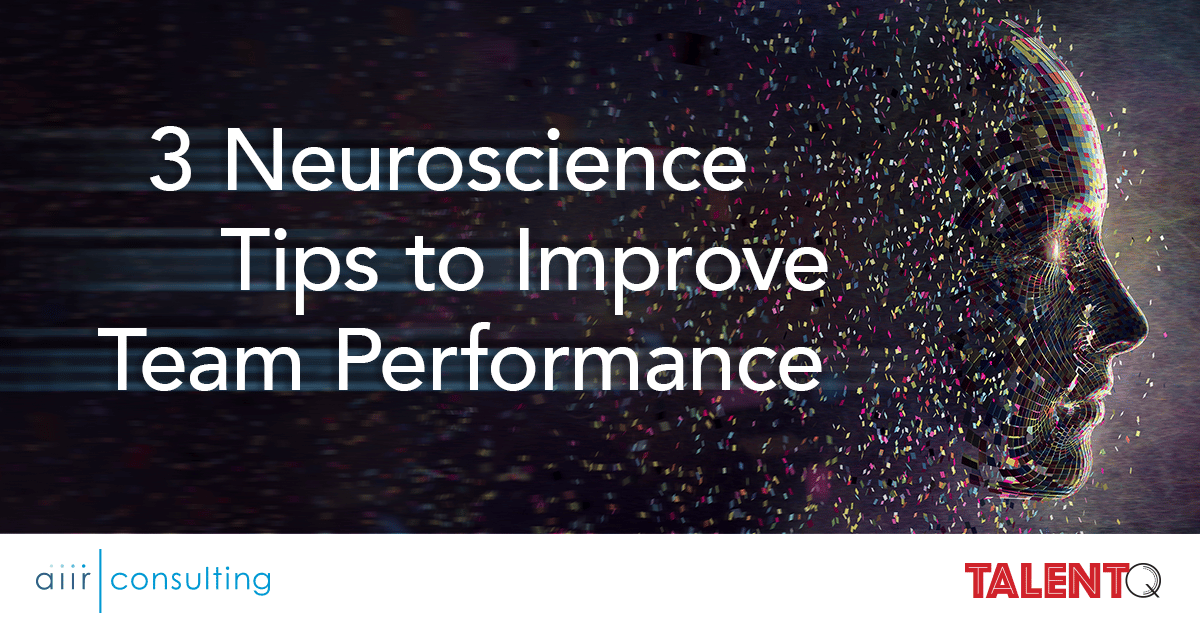With today’s rapidly-paced business environment, collaboration is essential for achieving results. However, when you’re responsible for the success of multiple teams, it can seem impossible to navigate the challenging dynamics that are key to unlocking your teams’ potential. And with an overwhelming variety of team philosophies on the market, how do you know what methods are actually proven to work?
In a recent article published in Talent Quarterly, AIIR CEO Dr. Jonathan Kirshner shared three neuroscience insights on how to set teams up for success.
“When the individuals on a team coalesce around a common mission, it can achieve parabolic outcomes.” said Dr. Kirschner in the article. “One plus one no longer equals two. On a high-performing team, one plus one equals three. This outcome isn’t magic. Instead, it’s rooted in well-researched and understood neuroscientific underpinnings that we can exploit to bolster team performance.”
Turning to neuroscience to strengthen team performance can help simplify your team strategy. Instead of making major changes to the team’s structure, you can leverage the fact that humans are evolutionarily hard-wired for working together.
“Connection is key to human existence” according to Michael Platt, Director of the Wharton Neuroscience Initiative, an AIIR partner. Dr. Platt is an expert on the neuroscience of teams and stresses that, “More than really any other animal species on the planet, our own destinies are linked to each other.”
To unlock the effectiveness of your teams, skip the trust falls and try these neuroscience tips instead:
Tip #1 – Leverage Oxytocin to Build Trust
Oxytocin, often called the “love hormone,” can be put to good use in your efforts with teams. Stressful situations can trigger the release of cortisol, inhibiting trust and creativity. But simple, positive interactions with others can release surges of oxytocin. When this happens, trust increases between individuals and we are neurologically more prepared for bonding.
Eye contact is one of the things that signals to the body that it is safe. This means that encouraging face-to-face interactions doesn’t just cut down on email, it actually prepares our brains to trust each other more. It also means that light moments — time spent checking in with one another or just chatting over lunch — aren’t “wasted time.” They are integral to building an environment in which oxytocin can flow.
Tip #2 – Ban Phones to Increase Synchrony
Speaking of building a successful environment, consider banning phones in some scenarios. When teams work together, their bodies and brains sync up in a very real and measurable way. Dr. Platt has even recently launched a new wearable EEG device that can measure brain activity over extended periods of time.
The potential synchrony teams can achieve is powerful. But, it is also easily disrupted. Each time you check your phone instead of actively listening to your team, that synchrony is lost. Imagine a room full of individuals dipping in and out of sync throughout an important decision. You probably don’t have to imagine it — you were probably in a meeting like that today.
So, for your big weekly meetings (and especially for more intimate 1:1s) a no-phone, laptop-closed policy can make a huge impact on the alignment and effectiveness of the team. If you really want to get the team dynamic humming, consider swapping out the lost phone time with a team mindfulness activity. This focus can bring individuals into sync in as little as 60 seconds.
Tip #3 – Practice Psychological Safety to Improve Team Discussions
Google’s Project Aristotle research showed that psychological safety is the number one predictor of successful team performance. Despite the fact that this research was published in 2015, most leaders still aren’t doing enough to create the conditions that foster psychological safety.
Whether through an offsite, team assessment, or team effectiveness program, teams that openly and honestly discuss their strengths and areas for optimization are more capable of identifying and removing obstacles in the way of future success. This candid discussion establishes psychological safety among team members.
Behavioral scientist Amy Edmondson, now Novartis Professor of Leadership and Management at the Harvard Business School, even describes psychological safety as “unusual, which is what makes it a competitive advantage.” Edmonson will be presenting on the topic of psychological safety in a knowledge-based economy at an upcoming AIIR-sponsored event in association with the Philadelphia Society for People and Strategy.
High-Performing Teams are Critical for Success
In today’s hyper-competitive, rapidly-changing environment, leaders can’t afford to underserve their teams. As Dr. Kirshner states, “By taking our cues from neuroscience, we can put in place practices that help our team members form the social bonds that enable the extraordinary.”
You can read the full article on the Talent Quarterly website.
Find out how to unlock their potential in our free whitepaper!
Are You Ready To Shape A Better Future Together?
Partner with AIIR to empower your leaders and ascend into the future.
